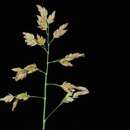Comments
provided by eFloras
Poa supine is very similar to
Poa annua but differs in its longer anthers and by having the spikelets crowded towards the tips of the branches. Frohner (l.c.) stated that Asiatic plants are distinct from European
Poa supine and proposed to accommodate them in a new species,
Poa ustulata Frohner. However, since the characters used to distinguish them not only overlap considerably, but are largely of a highly cryptic nature, no attempt has been made to test the distinction in our material. If Frohner is to be followed, then apparently all the specimens cited above should be referred to
Poa ustulata.1700–4300m.
- license
- cc-by-nc-sa-3.0
- copyright
- Missouri Botanical Garden, 4344 Shaw Boulevard, St. Louis, MO, 63110 USA
Comments
provided by eFloras
Poa supina has been divided into two taxa since the plants from C Asia, the Himalayas, and Xizang, including some but not all of the material from China, are more densely tufted and less stoloniferous than material from elsewhere. In addition, the branches are reduced to 1 per node, often rebranched near the base, and the palea looks minutely bumpy because of the globose, short cells between the veins. This material could be distinguished as P. supina subsp. ustulata. However, aside from the habit, the differences cited do not seem constant in the material from China, and material from NW China matches P. supina s.s.
- license
- cc-by-nc-sa-3.0
- copyright
- Missouri Botanical Garden, 4344 Shaw Boulevard, St. Louis, MO, 63110 USA
Description
provided by eFloras
Tufted, shortly creeping perennial; culms 6-25cm high, usually decumbent at the base. Leaf-blades usually flat, sometimes folded, 1-7cm long, 2-3mm wide, flaccid, abruptly tapering to a rather stout tip, scabrid on the margins; ligule blunt, 1-1.5mm long. Panicle pyramidal, 2-3cm long, loose; branches solitary or in pairs, the lower widely spreading, smooth. Spikelets 4-6-flowered, ovate, 3.5-5mm long, often suffused with purple; glumes unequal, the lower oblong, 1.5-1.7 mm long, 1-nerved, the upper elliptic, 2-2.5mm long, 3-nerved; lemmas elliptic or oblong-ovate in side-view, 2.5-3.5mm long, obtuse, ciliate on the keel and marginal nerves, without any wool at the base; palea shorter than the lemma, ciliate all along the keels; anthers (1.2-)1.6-2(-2.5)mm long.
- license
- cc-by-nc-sa-3.0
- copyright
- Missouri Botanical Garden, 4344 Shaw Boulevard, St. Louis, MO, 63110 USA
Description
provided by eFloras
Perennials, sometimes stoloniferous; shoots mostly extravaginal. Culms tufted or isolated, oblique, decumbent at base, frequently geniculate above, soft, (4–)8–20(–30) cm tall, 0.5–0.7 mm in diam., smooth, nodes 1 or 2(–3), 1(or 2) exserted. Leaf sheaths thin, smooth, basal ones drying pale brown and soon withering, enclosing culm bases, uppermost closed for 1/4–1/3 of length, 1.5–5 × longer than blade; blade light green, flat or folded, thin, 2–6 cm × 2–3 mm, surfaces smooth, margins smooth or sparsely scabrid, apex acutely prow-tipped; ligule 0.6–1.5 mm, abaxially smooth, glabrous, apex obtuse. Panicle open to loosely contracted, compactly pyramidal to ovoid, diffuse to moderately congested, (1.5–)2–5 cm, 1–2 × as long as wide; branches ascending to spreading, 1 or 2 per node, rounded, smooth, longest to 2 cm with 2–8 spikelets in distal 1/2. Spikelets ovate to oblong, light green, frequently purple tinged, 3.5–5(–6) mm, florets 3–6, distal fertile florets often female; vivipary absent; rachilla internodes 0.5–0.8 mm, smooth, glabrous; glumes unequal, smooth or sparsely scabrid, membranous-papery, lower glume lanceolate and acute to subflabellate and obtuse, ca. 1.5 mm, 1-veined, upper glume elliptic, 2–2.5 mm, margin angled, 3-veined; lemmas elliptic or oblong to ovate, membranous-papery, 1.4–3.5(–4) mm, keel and marginal veins sparsely villous or glabrous, smooth, intermediate veins distinct, margins smooth, apex obtuse; callus glabrous; palea keels smooth, hooks absent, shortly villous for most of length. Anthers (1.2–)1.5–1.8(–2.5) mm, or vestigial. Fl. and fr. Jun–Aug. 2n = 14, 28.
- license
- cc-by-nc-sa-3.0
- copyright
- Missouri Botanical Garden, 4344 Shaw Boulevard, St. Louis, MO, 63110 USA
Distribution
provided by eFloras
W. Europe, Scandinavia, N. Africa & Asia east to Himalaya & Mongolia.
- license
- cc-by-nc-sa-3.0
- copyright
- Missouri Botanical Garden, 4344 Shaw Boulevard, St. Louis, MO, 63110 USA
Distribution
provided by eFloras
Distribution: Pakistan (N.W.F.P., Gilgit & Kashmir); Europe eastwards to the Himalayas and the USSR.
- license
- cc-by-nc-sa-3.0
- copyright
- Missouri Botanical Garden, 4344 Shaw Boulevard, St. Louis, MO, 63110 USA
Distribution
provided by eFloras
Sichuan, Xinjiang, Xizang, Yunnan [Afghanistan, Kashmir, Mongolia, Nepal, Pakistan, Russia (Far East, Siberia), Tajikistan; SW Asia, Europe, North America].
- license
- cc-by-nc-sa-3.0
- copyright
- Missouri Botanical Garden, 4344 Shaw Boulevard, St. Louis, MO, 63110 USA
Elevation Range
provided by eFloras
1980-3600 m
- license
- cc-by-nc-sa-3.0
- copyright
- Missouri Botanical Garden, 4344 Shaw Boulevard, St. Louis, MO, 63110 USA
Flower/Fruit
provided by eFloras
Fl. & Fr. Per.: May–July.
- license
- cc-by-nc-sa-3.0
- copyright
- Missouri Botanical Garden, 4344 Shaw Boulevard, St. Louis, MO, 63110 USA
Habitat
provided by eFloras
Alpine and subalpine meadows on slopes, moist places; 1000–3100 m.
- license
- cc-by-nc-sa-3.0
- copyright
- Missouri Botanical Garden, 4344 Shaw Boulevard, St. Louis, MO, 63110 USA
Synonym
provided by eFloras
Poa variegata A. Haller, Cat. Pl. Helv. 38. 1800, not Lamarck (1791); P. annua Linnaeus var. supina (Schrader) Link; P. supina subsp. ustulata (S. E. Fröhner) A. Löve & D. Löve; P. ustulata S. E. Fröhner.
- license
- cc-by-nc-sa-3.0
- copyright
- Missouri Botanical Garden, 4344 Shaw Boulevard, St. Louis, MO, 63110 USA
Poa supina
provided by wikipedia EN
- license
- cc-by-sa-3.0
- copyright
- Wikipedia authors and editors
Poa supina: Brief Summary
provided by wikipedia EN
Poa supina is a species of flowering plant belonging to the family Poaceae.
Its native range is Morocco, Europe to Mongolia and Himalaya.
- license
- cc-by-sa-3.0
- copyright
- Wikipedia authors and editors

